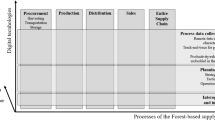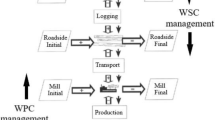Abstract
Forest industry plays a critical role for many remote rural regions in Nordic countries. Despite the increasing number of various digital transformation initiatives, many forestry organizations still use very traditional non-digitalized work practices in harvesting, logging, and support operations. Unfortunately, digital transformation is often performed as an ad hoc activity without a holistic approach to ensure ICT quality control. In this paper, we aim to answer the research problem of how digital transformation affects the quality of a forest machine operator’s operational processes and service systems. A case study research method with a single case structure was used in this study. The main contribution of the paper is to show that digital transformation shall benefit not only the forest machine operator organization but also their surrounding ecosystem by increasing transparency of operations, reducing travel costs, increasing productivity, and creating a more proactive operating model. Both sociological and technical aspects of digital transformation are discussed in the context of forest service management. Additionally, we show that in order to succeed in digital transformation, forestry organizations must pay attention to various quality aspects holistically: hardware quality, software quality, service quality, data quality, and process/project quality.


Similar content being viewed by others
Availability of data and materials
Not applicable.
Code availability
Not applicable.
References
Aaen, J., Nielsen, J, A., & Carugati, A. (2022). The dark side of data ecosystems: A longitudinal study of the DAMD project. European Journal of Information Systems 31(3):288–312. https://doi.org/10.1080/0960085X.2021.1947753
Ahmed, B., Bures, M., Frajtak, K., et al. (2019). Aspects of quality in Internet of Things (IoT) solutions: A systematic map** study. IEEE Access, 7:13,758– 13,780.
Axelos. (2017). Prince2 Handbook Managing Successful Projects With Prince. Stationary Office Books.
Blake, R., & Mangiameli, P. (2011). The effects and interactions of data quality and problem complexity on classification. Journal of Data and Information Quality, 2(2).
COBIT5. (2012). Control Objectives for Information and related Technology: COBIT 5: Enabling Processes. ISACA.
Duffy, K., & Denison, B. (2008). Using itil to improve it services. In: AMCIS08: Proceedings of the Fourteenth American Conference on Information Systems 2008. Association for Information Systems, Toronto, Canada.
Eisenhardt, K. (1989). Building theories from case study research. Academy of Management Review, 14, 532–550.
Ferrari, A., Bacco, M., Gaber, K., et al. (2022). Drivers, barriers and impacts of digitalisation in rural areas from the viewpoint of experts. Information and Software Technology, 145(106), 816.
Gabrys, J. (2020). Smart forests and data practices: From the internet of trees to planetary governance. Big Data & Society, 7(1–10), 362–377.
Hinze, A., Bowen, J., & König, J. (2021). Wearable technology for hazardous remote environments: Smart shirt and rugged iot network for forestry worker health. Smart Health, 23(100), 225. https://doi.org/10.1016/j.smhl.2021.100225
ISO/IEC 20000–1:2018. (2018) Information technology — Service management— Part 1: Service management system requirements. ISO/IEC JTC1/SC40 Secretariat.
ISO/IEC 20000:2. (2019). Part 2: Guidance on the application of service management systems. ISO/IEC JTC 1 Secretariat.
ISO/IEC 25010. (2011). Systems and software engineering — Systems and software Quality Requirements and Evaluation (SQuaRE) — System and software quality models. ISO/IEC JTC1/SC7 Secretariat.
ISO/IEC TS 15504–8:2012. (2012). Information technology Process assessment-Part 8: An exemplar process assessment model for IT service management. ISO/IEC TC JTC1/SC7 Secretariat.
Jäntti, M., & Aho, M. (2022). Improving the quality of ict and forestry service processes with digital service management approach: A case study on forestry liquids. In: Vallecillo A, Visser J, Pérez-Castillo R (eds) Quality of Information and Communications Technology. Springer International Publishing, Cham, 175–189.
Khanna, A., & Kaur, S. (2020). Internet of things (iot), applications and challenges: A comprehensive review. Wireless Personal Communications, 114, 1687–1762. https://doi.org/10.1007/s11277-020-07446-4
Lim, N. K., Chiong, C. W. R., Yap, C. S., et al. (2021). The effect of system quality attributes on the intention to use e-agrifinance. In: Proceedings of the 2021 International Conference on Green Energy, Computing and Sustainable Technology (GECOST). IEEE, 1–5.
Maglio, P., & Spohrer, J. (2007). Fundamentals of service science. Journal of the Academy of Marketing Science, 36, 18–20.
Marcu, A. E., Suciu, G., Olteanu, E., et al. (2019). Iot system for forest monitoring. In: 2019 42nd International Conference on Telecommunications and Signal Processing (TSP), 629–632. https://doi.org/10.1109/TSP.2019.8768835
Mohammed, S. K., Kamruzzaman, S. M., Ahmed, A., et al. (2019). Design and implementation of an iot based forest environment monitoring system. In: 2019 IEEE 5th International Conference on Computer and Communications (ICCC), 2152–2156.
Moshell, M. (1993). Three views of virtual reality: Virtual environments in the us military. Computer, 26(2), 81–82.
Office, C. (2011). ITIL service operation. The Stationary Office, UK.
Rivera, M., Becker, P., & Olsina, L. (2016). Quality views and strategy patterns for evaluating and improving quality: Usability and user experience case studies. Journal of Web Engineering (JWE), 15, 433–464.
Rönnqvist, M., D’Amours, S., Weintraub, A., et al. (2015). Operations research challenges in forestry: 33 open problems. Annals of Operations Research, 232.
Runeson, P., & Höst, M. (2009). Guidelines for conducting and reporting case study research in software engineering. Empirical Software Engineering, 14, 131–164.
Satava, R., & Jones, S. (1996). An integrated medical virtual reality program. the military application. IEEE Engineering in Medicine and Biology Magazine, 15(2):94–97.
Shrestha, A., Cater-Steel, A., Toleman, M., et al. (2014). Towards transparent and efficient process assessments for it service management. In: Software Process Improvement and Capability Determination, Communications in Computer and Information Science, vol 477. Springer International Publishing, 165– 176.
Software Engineering Institute. (2010). Capability maturity model integration for services v1.3. Carnegie Mellon University.
Sommerville, I. (2016). Software engineering. Pearson Education Limited.
Spohrer, J., Vargo, S., Caswell, N., et al. (2008). The service system is the basic abstraction of service science. In: Proceedings of the 41st Annual Hawaii International Conference on System Sciences (HICSS 2008). IEEE Press, New York, NY, USA.
Vianez, A., Marques, A., & Almeida, R. (2022). Virtual reality exposure therapy for armed forces veterans with post-traumatic stress disorder: A systematic review and focus group. International Journal of Environmental Research and Public Health, 19, 464.
Wang, Y., Song, J., Liu, X., et al. (2013). Plantation monitoring system based on internet of things. In: 2013 IEEE International Conference on Green Computing and Communications and IEEE Internet of Things and IEEE Cyber, Physical and Social Computing, 366–369.
Westerberg, S., & Shiriaev, A. (2013). Virtual environment-based teleoperation of forestry machines: Designing future interaction methods. J Hum-Robot Interact, 2(3), 84–110.
Yin, R. (1994). Case study research: Design and methods. Sage Publishing.
Zhang, L. J., Zhang, J., & Cai, H. (2007). Services computing. Tsinghua University Press.
Acknowledgements
We would like to thank for the financial support received during the Development of AIKA Ecosystem in Kainuu project (Regional Council of Kainuu, A78688) and DIH-World project (co-funded by the Horizon 2020 Framework Programme of the EU under grant agreement No 952176).
Funding
This work was supported by the Development of AIKA Ecosystem in Kainuu project (Regional Council of Kainuu, A78688) and DIH-World (co-funded by the Horizon 2020 Framework Programme of the EU under grant agreement No 952176).
Author information
Authors and Affiliations
Contributions
Marko Jäntti and Markus Aho contributed equally to this work.
Corresponding author
Ethics declarations
Ethics approval
Not applicable.
Consent to participate
Not applicable.
Consent for publication
Not applicable.
Competing interests
The authors declare no competing interests.
Additional information
Publisher's Note
Springer Nature remains neutral with regard to jurisdictional claims in published maps and institutional affiliations.
Marko Jäntti and Markus Aho contributed equally to this work.
Rights and permissions
Springer Nature or its licensor (e.g. a society or other partner) holds exclusive rights to this article under a publishing agreement with the author(s) or other rightsholder(s); author self-archiving of the accepted manuscript version of this article is solely governed by the terms of such publishing agreement and applicable law.
About this article
Cite this article
Jäntti, M., Aho, M. Quality aspects of digital forest service management: a case study. Software Qual J 32, 75–94 (2024). https://doi.org/10.1007/s11219-023-09635-3
Accepted:
Published:
Issue Date:
DOI: https://doi.org/10.1007/s11219-023-09635-3




